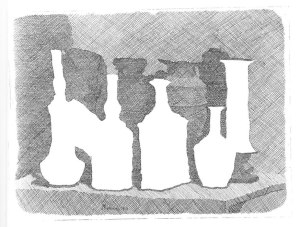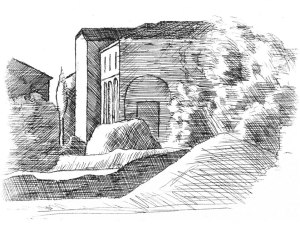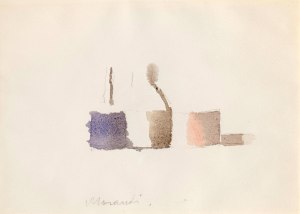The Estorick Collection of London shed different light on Giorgio Morandi.
The Estorick Collection of London shed different light on Giorgio Morandi.
David Franchi – Sunday, 26th May 2013.
“His contribution to the world of art is priceless”
The exhibition “Giorgio Morandi: lines of poetry” was very interesting. It had shed a new and different light on our knowledge of Giorgio Morandi.
On show at the Estorick Collection of Modern Art, London, “Giorgio Morandi: lines of poetry” celebrated the 15th anniversary of the gallery. The exhibition has been held from 16th January until 7th April 2013 and prolonged to the 28th April.
Displayed there were around 80 pieces mainly etchings and with four watercolours spanning through the career of the artist from Bologna. Morandi was working even during the Second World War and in Bologna, a territory that was terribly struck by the conflict. Morandi is considered one of the most important artists from the past century. His contribution to the world of art is priceless.
The three rooms of the exhibition “Giorgio Morandi: lines of poetry” at the Estorick Collection, London, were interesting, because spanning of the entire career of the artist.
The first room considered mainly etchings from the early Morandi. The second room also presented works of Morandi, but most important was a big screen projecting a subtitled video which completed the exhibition. It was a 60 minutes documentary by Mario Chemello, titled “Giorgio Morandi dust: three houses” (2011). The three houses in question are the ones which Morandi has used in his life, the most important for him. Therefore, the documentary is also a view that spans over more than 30 years of the artist life. The three houses considered by this footage are the house of Morandi in Bologna, his den in Grizzana, and his virtual house which is the world in the sense of being part of museums.
Morandi lived with his mum and three sisters. He spent the whole of his life with them. Women of his house were not allowed to remove dust from the bottles he vastly collected in his room which was also his studio. According to critic Laura Mattioli Rossi, the daughter of Gianni Mattioli – one of the most important, enlightened and enthusiastic collectors of the early 20th century Italian avant-garde art – dust is part of Morandi’s art and it can be seen on his paintings. Eugenio Riccomini reports he saw Morandi using the shutters to regulate the lights that were illuminating objects in his room that looks like a storage place.
Morandi’s painting recalls of theatrical stage where objects are users as actors. Morandi used everyday life objects and transformed

Giorgio Morandi, Still Life of Vases on a Table, 1931, Etching, Courtesy Galleria d’Arte Maggiore G.A.M., Bologna
them with bricolage and then used them as subjects of his painting by resembling to human bodies playing theatre acts.
Etchings of Morandi are a direct inspiration from Rembrandt. The work of Morandi catches the ungraspable sense of existence in the object surrounding us.
At the third floor, together with the four watercolours and a few more etchings of Morandi, it was possible to see photographs by Nino Migliori, also from Bologna. This series of photographs is “Imagined landscapes: the places of Morandi” and it was realised during the 1980s by Migliori in Grizzana, the little village in the Appennino mountains near Bologna, where Morandi was used to spend his summer holidays. In this little village so important for the Morandi work, partially the documentary “Giorgio Morandi dust: three houses” was also shot.
The exhibition “Giorgio Morandi: lines of poetry” was organised in collaboration with Galleria d’Arte Maggiore of Bologna, with lendings from private collections and from Estorick collection.
Morandi was a solitary man. He was involved with the movement of Futurism of Marinetti and also with the Metaphysics School of De Chirico.
Giorgio Morandi was born 20th July 1890 in Bologna. Mainly still life and landscape, his painting are famous for the delicacy of the tonalities with which he was representing simple subjects, including vases, bottles, bowls, flowers and landscapes.
From 1907 to 1913 he studied at the Accademia di Belle Arti of Bologna. In 1909 Morandi’s father died and the family moved to via Fondazza n. 36, and he became the head of the family. The Morandi family lived on via Fondazza, three sisters Anna, Dina and Maria Teresa, until the artist death on 18th June 1964.

Giorgio Morandi, Small House with Portico and Cypress, 1924,
Etching, Courtesy Galleria d’Arte Maggiore G.A.M., Bologna
Quiet, polite both in his private and public life, Morandi was much talked in Bologna for his enigmatic yet very optimistic personality. However he had a very positive personality. He worked all his life as a teacher in the school, apparently without giving much importance to money and success.
Giorgio Morandi has always worked in his room in via Fondazza. That artists could have his own studio only in 1960, when the family built its own house in the little village of Grizzana – which in 1985 changed its name in Grizzana Morandi as homage to the artist.
Morandi was one of the few Italian artists who could avoid being involved with Fascism. He was keen to Modernist abstraction for his style was of a very simple execution. He inspired Minimalism. He also was attributed by other great artists such as Federico Fellini in his film “La Dolce Vita”, and in “La notte” by Michelangelo Antonioni. One of the main characters in Sarah Hall’s novel “How to Paint a Dead Man” is clearly based on Morandi. Don DeLillo’s 9/11 novel “Falling Man” (2007) includes two Morandi still-life paintings.
Two oil paintings by Morandi were chosen by the President of the United States Barack Obama in 2009 and are now part of the White House collection.
In 1993, Mrs. Marilena Pasquali and Bologna Municipality opened the Giorgio Morandi Museum, thanks to the donation made by his sister Maria Teresa Morandi, of his works and his atelier, which were owned by the family. Today the museum includes a reconstruction of his studio.
The exhibition “Giorgio Morandi: lines of peotry” was at the Estorick Collection, Highbury, London, from 16th January until 28th April 2013.

